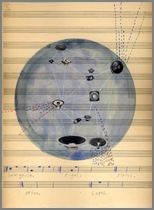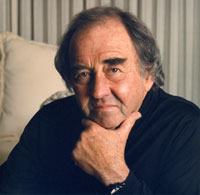 Dude!
Dude!
Next week those SOB’s from Lost Dog get their season off to a hooowwwling start with a program at Tenri they call “Color Wheel.” Lost Dog top dog Garth (“Arf!”) Sunderland explains:
The focus of this program is instrumental color – the astonishing variety of sounds even a single instrument can produce. Each instrument in the concert (Clarinet, ‘Cello, and Piano) will be experienced individually in the first half of the program, in virtuosic solo works which explore their unique color pallete – the ‘sound-identity’ of the instrument. In the second half, all three instruments come together to explore and experience those colors interacting with each other, in a very rare performance of Helmut Lachenmann’s timbral masterpiece, Allegro Sostenuto.
Those first half pieces are by Ligeti, Xenakis, and Donatoni. (Ouch-kabibble.)
The real deal takes place next Saturday night (10/25) at Tenri Cultural Institute, a joint which is finally about to live up to its middle name. There’s a preview program the night before at Waltz-Astoria. C-ya!
 My first year in college (1974-5), we were treated to an exhibition of the original score pages selected by John Cage and Alison Knowles for their highly influential 1969 book Notations (currently
My first year in college (1974-5), we were treated to an exhibition of the original score pages selected by John Cage and Alison Knowles for their highly influential 1969 book Notations (currently  I’m mentioning this because down here in Houston I just received a little whiff of that wonderful déjà vu this afternoon. The Contemporary Arts Museum Houston has a show up and running through December 7th, titled
I’m mentioning this because down here in Houston I just received a little whiff of that wonderful déjà vu this afternoon. The Contemporary Arts Museum Houston has a show up and running through December 7th, titled  Unlike the album driven days of yore, today it’s all about the mix. From purchasing single tracks digitally at online stores such as Itunes and Amazon to the internet radio sensation Pandora, which tailors ‘stations’ to a listener’s preferences, music is presented as eminently accessible; instant gratification, inevitable. While all aforementioned methods of mix are exciting in their potential for discovery, surfing the impossibly
Unlike the album driven days of yore, today it’s all about the mix. From purchasing single tracks digitally at online stores such as Itunes and Amazon to the internet radio sensation Pandora, which tailors ‘stations’ to a listener’s preferences, music is presented as eminently accessible; instant gratification, inevitable. While all aforementioned methods of mix are exciting in their potential for discovery, surfing the impossibly  In 2002,
In 2002,  Gabriel Kahane
Gabriel Kahane Another full house at Zipper Hall, and we enjoyed ourselves with the music of
Another full house at Zipper Hall, and we enjoyed ourselves with the music of  New York’s NPR station WNYC has been doing a bunch of programming on Leonard Bernstein, and the other night when I was moving my car I heard a great story:
New York’s NPR station WNYC has been doing a bunch of programming on Leonard Bernstein, and the other night when I was moving my car I heard a great story: Gloria Cheng
Gloria Cheng Violinist Anne-Sophie Mutter is continually creating something new – from concerti by Krzysztof Penderecki and Andre Previn to works by Sebastian Currier and Henri Dutilleux.
Violinist Anne-Sophie Mutter is continually creating something new – from concerti by Krzysztof Penderecki and Andre Previn to works by Sebastian Currier and Henri Dutilleux.